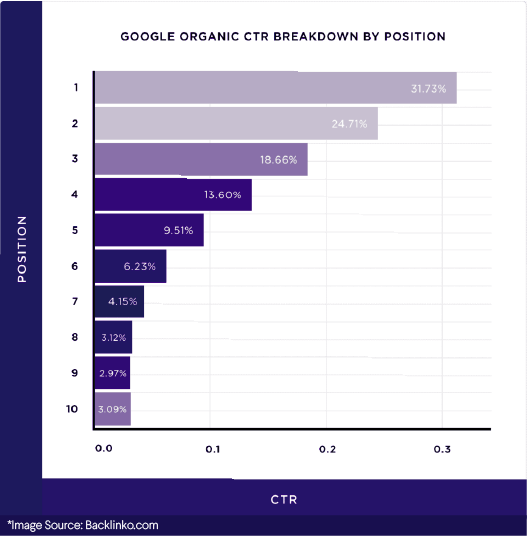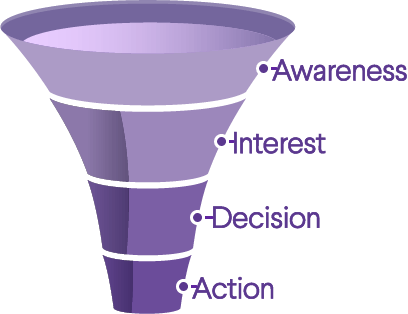Stage 1 of our award-winning three stage strategy is Research. This stage involves our team doing a full research into your target audience and their online buying habits. You will receive a comprehensive analysis of all of the keywords that a potential customer might search for with each category of products, along with their associated impression count and search volume. We will then use that research to identify an optimal website structure.
We will begin by assessing your total market size and potential reach (also known as search visibility). The total market size is based on the total number of impressions and clicks for your products appearing on Page 1 of Google search results. Similarly, the potential reach is how many searchers will see your website in search results. The top search result has the most views and clicks, approximately 32%*, and this gradually decreases to only 3% for the tenth position.
Additionally, we will share a comprehensive competitor analysis of your top 4 competitors. This will include the total keywords each have ranked for over the past 12 months and their associated positions in search results. Careful consideration is made into how much of your competitor's traffic is branded traffic compared to non-branded traffic. The purpose of this is to understand your brand’s current positioning, and to better understand how we can grow your Organic channel.

The keywords we identified will be both broad terms and specific terms. The more specific or niche keywords often signify that the searcher is closer to buying and is likely to be higher converting. Broader keywords will often have a higher search volume and a lower conversion rate (as the shopper may not be entirely sure what they are looking for).
The research will show you the suggested H1 tag, URL and popular keywords for each website page. It will also show you how many and which specific keywords each page will be targeting, including their monthly search volume. In the summary section, you will also see how many new categories and keywords we identified and the total potential new impressions (website traffic) that we can give you.
Not only can this research be used to improve your website’s SEO, but it can also be used for your other marketing efforts.
*https://www.sistrix.com/blog/why-almost-everything-you-knew-about-google-ctr-is-no-longer-valid/

How to use the research we found in your other marketing streams
You can utilise the keyword data we have found in your Google Ads as keywords to target. It is recommended that you review your Google Ads settings frequently so during this time, you can review which keywords receive the highest click-through rate and purchases. Then simply use this data, combined with the data found in our Research page, to determine which keywords you should target for your next Google Ads campaign.
There is also the concept of SEO for social media accounts. Customers will often search Instagram, TikTok, Linkedin, etc for brands and products. Use some of the high quality keywords identified in the research stage in your bio. Particularly, try using the keywords we have found for your homepage, as they are the most broad. But also try keywords for your best selling products, as they can be more niche. The keywords can also be good options for hashtags and caption content.
If you see a product that has a high search volume versus one that has a low search volume, which one would you think is better to add to a sale? The high search volume product! This means that more people are searching for this particular product, so if yours is on sale (they’ll be able to tell from the schema markup), they are more likely to click on your website. Even if they choose not to purchase, they are still more likely to remember your brand name and come back later.
You will be able to see the products and categories of products that have a high search volume. If a specific product has a very high search volume, then we recommend purchasing more of the product, as it is clearly highly valued in the market. For these products, you may need to lower the price to be competitive with your competitors, run sales or promote them through other marketing channels.
If you do not stock a product that has a very high search volume and is within your niche, this may be something you should consider doing. Perhaps you sell automotive exhausts for different car brands. The research might find that a specific brand and make/type of vehicle is something customers are looking for. This is a good opportunity to get ahead of your competitors and purchase this new product to add to your collection.
Not only can the keywords we have researched be used for product descriptions and category pages, but they can also be used for writing blog posts. Use the keywords in the blog content, as ideas for topics or in the Alt text for images.
The keywords we have found will target every level of the sales funnel, from the awareness phase (shoppers searching for your brand or industry) down to the action phase (where buyers are ready to purchase). Shoppers in the awareness phase will be searching with broad keywords, such as “cocktail dress”, “model plane” or “baby bassinet”. Alternatively, buyers in the action phase will be searching by ultra niche keywords, such as “chocolate plant based protein powder” or “womens 7/8 length high compression leggings”.

To find out how we can help your business, get in touch
Get in touch